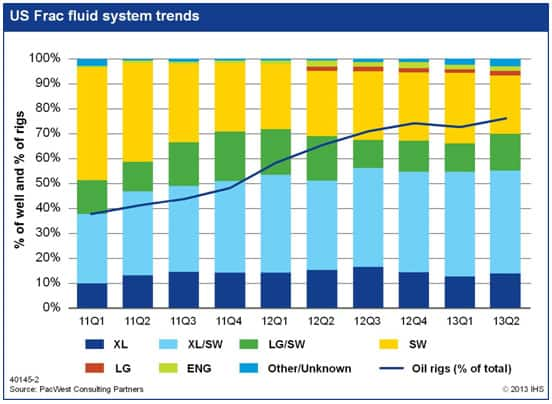Hydraulic fracturing and wastewater reuse: The role of fluids in water management and operations predictability
Reuse of oilfield fracturing fluid may double in the next 10 years. Benefits include cost saving and a more reliable water supply which contributes to well productivity.
Many exploration and production companies face the challenge of balancing operational risk from interruptions to water supply with technical risk from oilfield wastewater reuse programs that might affect well performance. Technical design details are key to this optimization, including the choice of fracture fluid system and the physical and chemical parameters of the oilfield wastewater. Our understanding of the interaction between water quality and fracture fluid systems has changed drastically in recent years. Significant economic incentive exists to increase oilfield wastewater reuse, and as the types of fracture fluid systems evolve, the economic incentive and viability of oilfield wastewater reuse will also evolve.
Strong economic incentives for oilfield wastewater reuse A recent conversation with the head completion engineer for a major exploration and production company confirmed that there is a significant lost revenue concern when ineffective water management causes water-shortage impacts to an operator's drilling and completion program. Analysis IHS conducted on the impact of drought conditions in 2011 presents one case in which an operator experienced approximately $750 million in lost revenue* as a result of water-management-driven changes to the companies drilling and completion program.
For many regions in United States, the volume of water used in hydraulic fracturing programs is small compared to other industrial uses. However, drilling and completion schedules are increasingly impacted by regional drought and elevated concern about local water supply stress. Risk of interruption to water supplies and the impact on drilling and completion programs is a critical driver influencing new water-management strategies. It is this economic risk that creates the incentive to invest in water-management infrastructure and adopt oilfield wastewater reuse programs.
Uncertainty in the water specification Development of oilfield wastewater reuse programs often starts with a chicken-and-egg type conversation in which operators, oilfield service providers and water management service companies all look to each other for verification and validation on the water quality specification. The influence of suspended and dissolved constituents in a given water source is a topic of great debate in the technical literature. Driven by operational performance data on the fracture fluid systems available in the market, the answer historically has been a specification for freshwater. With uncertainty about the potential operational risk, all parties tend to drive toward a water source that is low in total dissolved solids and, in particular, low in specific divalent cations and metals that interfere with fracture fluids or increase the scaling tendency of the fluid being pumped downhole.
Measuring and managing water quality to ensure compatibility with fracture fluids and prevent scaling can be a technical and logistical challenge in the field. As such, for many reuse programs, slickwater fracture fluids have been preferred by many operators, in part due to their strong performance despite variations in water chemistry. In oilfield wastewater reuse programs, cross linked gel fracture fluids historically increased operational risk. Interaction between the gelling agent and cross linker with background chemical constituents creates variability in the fluid rheology impacting downhole performance.
Increased use of cross linked gel The main function of a fracture fluid is to stimulate the formation and to place proppant along the length of the open fractures. Varied by fracture-fluid type, mechanisms for proppant placement involve manipulating velocity, viscosity, and elastic properties of the hydraulic fluid and pumping regime. In addition to providing effective proppant transport properties, the fracture fluid must achieve a number of key goals: 1) Exhibiting low-friction pressure during pumping 2) Leaving low residue once the treatment is over 3) Providing controls for fluid loss within the formation 4) Breaking viscosity controllably with efficient recovery of the fluid from within the fracture
As shown in the graphic below, analysis of the fracture fluid market by PACWest Consulting Partners illustrates a decline in pure slickwater (SW) fracture programs and an increase in programs using cross link (XL) and hybrid approaches. This combination of increased fluid viscosity coupled with operators looking to increase oilfield wastewater reuse has driven oilfield service providers to develop new products. In the Bakken formation, Halliburton and Statoil recently demonstrated one example of a cross linked fracture fluid system by fracturing wells using produced water that has greater than 200,000 mg/L total dissolved solids.
The economic incentives for oilfield wastewater reuse are strong and the market for fracture fluid systems tolerant to the chemical constituents in oilfield wastewater will continue to grow. IHS analysis illustrates that significant economic drivers can exist to double the volumes of water that are reused over the next ten years. A future column will explore the role that other fracture fluid systems, including waterless fracturing systems, may have in the US landscape. *IHS research and analysis identified $12 million in lost revenue per well for between 60 and 70 wells. Source: IHS study titled "The Future of Water in Unconventionals: Water eg

Posted 18 March 2014
This article was published by S&P Global Commodity Insights and not by S&P Global Ratings, which is a separately managed division of S&P Global.